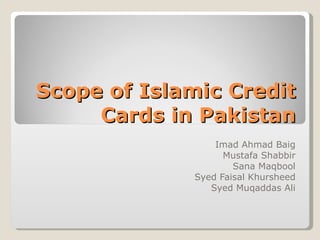Islamic Credit Cards in Pakistan
- 1. Scope of Islamic Credit Cards in Pakistan Imad Ahmad Baig Mustafa Shabbir Sana Maqbool Syed Faisal Khursheed Syed Muqaddas Ali
- 2. Introduction Islamic Credit Card- SaŌĆÖadiq Background of Islamic Credit Card
- 3. Differences between Islamic and Conventional Credit Cards Non- ShariaŌĆÖh Compliant Money lending Compounding profits No control over transactions/merchants ShariaŌĆÖh Compliant No money lending None compounding profit Control on transactions Conventional Islamic
- 4. Purpose of Research Objective of Research To identify the level of awareness among the customers To identify what level of perception Islamic credit cards carry amongst Pakistani masses To identify the willingness to own/switch to Islamic Credit Cards Limitations Time Constraints Limited availability of Respondents Authentic prior research in Pakistan
- 5. Research Methodology Population All bank account holders Sampling Size 200 respondents Geographically Restricted to Karachi Convenience Sampling Techniques
- 6. Questionnaire adopted from prior study on Islamic Credit Card holders-Nuradli & Abdul Hamid.
- 8. Demographics 65% 35% 65% 35%
- 9. ╠²
- 10. ╠²
- 11. Ownership of Credit Card 60% 40%
- 12. Type of Credit Card Ownership 42% 44% 10% 3%
- 13. Awareness of Islamic Credit Cards
- 14. Awareness of Islamic Credit Cards (Age)
- 15. Awareness of Islamic Credit Cards (Monthly Income)
- 16. Promotion of Conventional vs Islamic Credit Card
- 17. Perception of Islamic Credit Card
- 18. Perception of Islamic Credit Card (Age)
- 19. Perception of Islamic Credit Card (Monthly Income)
- 20. Willingness to own Islamic Credit Cards 65% 35%
- 21. Willingness to own Islamic Credit Card (Age)
- 22. Willingness to own Islamic Credit Card (Monthly Income)
- 23. Willingness to Switch from Conventional to Islamic Credit Card 60% 30% 8%
- 24. Conclusion Severely low knowledge regarding Islamic credit cards Most of consumers have a negative perception about Islamic Credit Card Majority of people are willing to own/switch
- 25. Recommendations Banks should come up with more promotional campaigns Banks should develop a program so as to clear the misconceptions amongst most consumers. This will help improving the perception.
- 26. Chakravorti and Ted, (1997). ŌĆ£Economic Perspectives: A Review from the Federal Reserve Bank of ChicagoŌĆØ, Research Dept. of the Federal Reserve Bank of Chicago. University of California. Chapra, M. U. (1986). ŌĆ£A discussion of money, banking and monetary policy in the light of Islamic teachingsŌĆØ. Towards a Just Monetary System, pp. 55-56. Leicester: The Islamic Foundation. MaŌĆÖsum Billah, M. (2004). ŌĆ£Islamic Credit Card in PracticeŌĆØ. In ICMIF Series of Articles: External papers (Takaful Islamic Finance). International Cooperative and Mutual Insurance Federation, URL: http://www.icmif.org/2k4takaful/site/documents/Islamic%20Credit%20Card.doc (14/03/2009) Wonglimpiyarat, J. (2005). ŌĆ£Innovation Management in a Complex Economic EnvironmentŌĆØ. Strategies of Competition in the Bank Card Business, pp. 21-25. Brighton: Sussex Academic Press. References
- 27. JazakŌĆÖ Allah
Editor's Notes
- 40 60


























